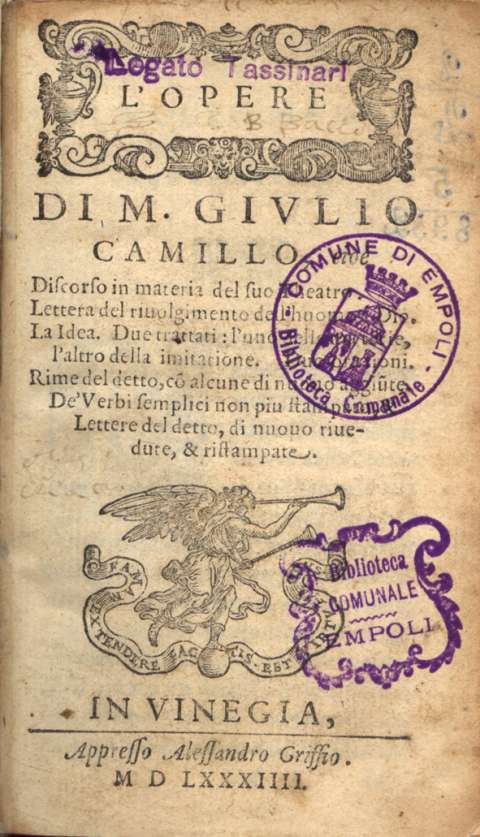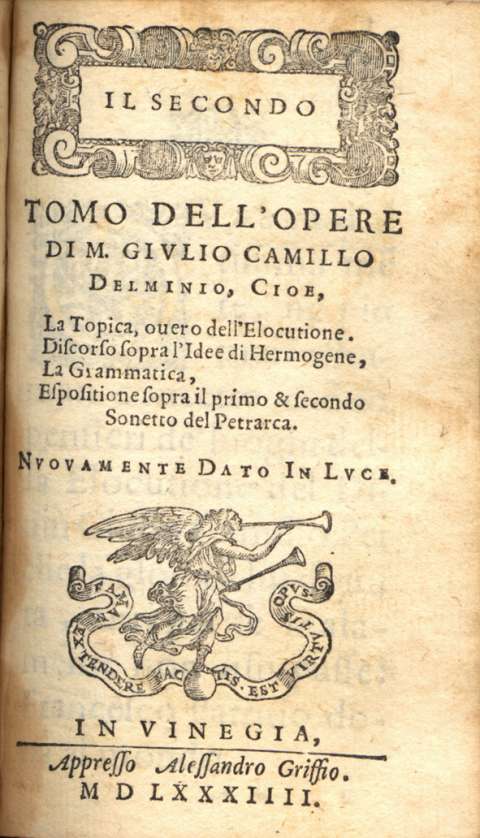Abracadabra: Language, Memory, Representation
Reading for today: Chapter 6 of Yates. Please also read the following short article by Peter Mattusek: The Renaissance of the Art of Memory
Memory Theaters in the Renaissance: Giulio Camillo
Camillo's Theater
- A Virtual(?) Memory Theatre
- Hermes Trismegistus
- Marsilio Ficino (and Cosimo de Medici)
- Pico Della Mirandola
- Francis Yates Reconstruction
- Detail 1
- Detail 2
Perhaps the most famous--and most bizarre--memory theater is that of Giulio Camillo Delminio (1480-1544). Camillo was an italian scholar, renowned, it appears, for his speech impediment, his corpulence, his bad Latin, but most of all, his fantastic wooden memory theater.
It is hard to know exactly, from the sources available, what purpose Camillo intended his theater to have. It is clear however, that it is quite distant in form from the other arts of memory we've looked at. In fact, the theater as planned really had very little to do with memory-- it was more like a glorified filing cabinet.
We have already looked at the connection between the memory systems of the ancient world, and the emerging culture of literacy, books and encyclopedic knowledge. The link between the memory systems and the desire to give order to knowledge is strong in this period. Camillo's memory theatre might best be imagined as a link between memory and the encyclopedia. It is an encyclopedia, however, filled with bizarre pages.
Camillo's theatre was destroyed, if it ever existed, and we are left only with a book, published posthumously, containing his various plans and ideas. Yates reconstructs a version of his theatre from this book.
Camillo's Theatre in more detail...
Renaissance Hermeticism and the Role of Magic
The strain of philosophy (or is it science?) known as "hermeticism" rests on an unfortunate error. In the late 15th century, just as the printing press is starting to roll, Marsilio Ficino is asked by Cosimo de Medici to translate some ancient texts that Medici has acquired. Ficino is a scholar of ancient greek, a humanist, and one of the main believers in Platonic philosophy as a route to good clean living in the Renaissance. Nonetheless, before translating Plato, Ficino decides to translate work that he believes to be the writings of the ancient (pre-Platonic) scholar Hermes Trismegistus (he wasn't alone in his belief, but took Augustine as an authority on the matter). Two texts, Corpus Hermeticum and Asclepius form the basic works. They cover learning, philosophy, mathematics, medicine, alchemy and magic. They make a big splash in the Renaissance, since it is a time of rediscovery of ancient knowledge. Ficino and others assumed this was the most ancient of scholarship-- ancient Egyptian mysteries. The unfortunate error was that they were not ancient texts: old, but not ancient. In 1614, a philologist, Isaac Causabon, demonstrates that the texts belong to a 2nd century A.D. collection, perhaps a collection of various authors, but definitely not pre-Platonic, and certainly not ancient Egyption.
Nonetheless, the works were incredibly influential and widely read. In fact, Francis Yates previous work Giordano Bruno and the Hermetic Tradition suggests that there is an important, and misunderstood connection between the scientific revolution, and the Hermetic tradition.
The works contain a bizarre version of a creation story. It is perhaps the first truly multicultural text, combining ideas, words, images and learning from hellenistic, roman, Christian, Egyptian, Persian, and perhaps other sources as well. The mixture of traditional ideas was profound enough that it created an alternative to both mainstream Catholicism and to Medieval Aristotleianism in the Renaissance.
Yates describes some of the aspects of this magical-spiritual theory (151-59).

